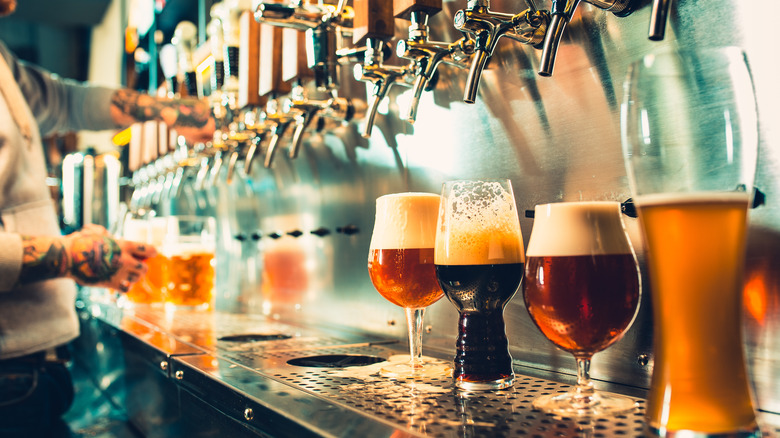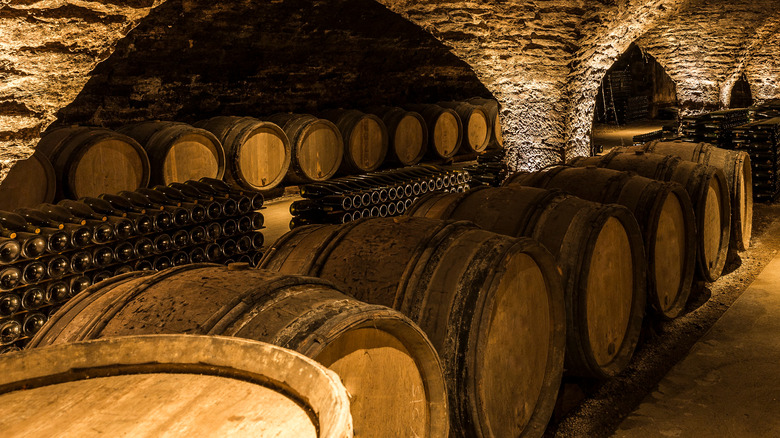What's The Best Type Of Glass For A Lager?
Any novice beer drinker has probably asked themselves at least once, "What's the best way to serve a beer?" The shortest answer: cold. But going beyond just the chill factor, there are a handful of different vessels for drinking beer. Cans and bottles have their spot in the grocery aisle, pints and mugs are popular at the pub, and pilsners, weizen beers, and Irish stouts (like Guinness) even have their own style-specific glasses. But with the prominence of lagers in modern beer culture, you may wonder which glass is perfect for them, and what makes that glass better than a bottle or can.
For one, aluminum cans don't insulate as well as glass; they conduct more heat from your hand to the beverage so your beer doesn't stay as cold for as long, says the American Institute of Chemical Engineers. Conversely, glass bottles are better at insulating the beer, but they are heavier to ship, are frowned upon at parks and beaches, and don't quite showcase the nuanced qualities of a craft beer nor enhance the drinking experience the way a style-specific glass might.
In the world of beer, there is a variety of glassware options designed to bring out the best of your beer depending on the style. Advanced Mixology explains how glass shape affects the retention of carbonation, smell, and appearance, which interplay to affect the beer-drinking experience. But to know which glass best suits a lager, we first need to identify what exactly a lager is.
What makes a lager?
To start off, in the world of beer brewing, there are two households alike in dignity: lagers and ales. The main difference between lagers and ales is the type of yeast used as well as the way in which the beer ferments. In both brewing processes, the grains, hops, and malts are steeped together to make wort (unfermented beer). Allagash Brewing Co. tells us that while ale yeasts ferment more quickly and at warmer temperatures (60 to 75 degrees Fahrenheit), lager yeasts do their best work low and slow, at temperatures (42 to 55 degrees Fahrenheit).
In fact, the term for lager comes from the German word lagern meaning "to store," because these beers were left to mature in cold-storage caves during the medieval period, according to Brewer World. The lager family includes helles, pilsner, bock (with its own handful of sub-styles), Vienna lager, märzen (the traditional Oktoberfest beer), dunkel, and schwarzbier. Due to the popularity and mass distribution of lager-style light beers, it's assumed that lagers are inherently lighter in color. However, both lagers and ales can range from light to dark based on the intensity of the roast or malt of the grains used, Allagash explains. Because of this variation within the lager family, it's difficult to designate any one specific drinking vessel as "best"; instead, we have to consider how glassware attempts to enhance the drinking experience for the type of beer at hand.
Showcasing the lager with a flute glass
Keep in mind, the wrong glass won't ruin a good beer, but pouring a beer into a glass helps activate the carbonation that creates the pillowy, foamy head. Shape and width play an important role, too; a glass with a more narrow mouth (like a pilsner glass) helps to retain that head by reducing the amount of surface area where carbonation can be lost, says the Homebrewer's Association. Similarly, glasses that have a narrower, vase-like base (like a weizen glass) are best for hazy or unfiltered beers like the weizen itself, per Kegerator, allowing for sediments to settle at the bottom while still retaining aromas and controlling any excessive foaming at the head.
Ultimately, flute glasses are preferred for the majority of lagers for this very reason, Vine Pair advises. The tall, narrow glass promotes head retention, showcases color and clarity, and enhances the aromas of lighter, more nuanced lagers and pilsners. However, like all families, the lager family does have a couple of black sheep that are better represented in alternative glasses. Dunkelweizen and weizenbock beers are best showcased in a weizen glass where the full-bodied aromas can be held in the bulb of the vase, says Beer Chronicle, while fest beers like märzen lagers served in high volume often find themselves in thick-walled mugs to stay cold longer.
Not all lagers are the same, nor all drinking vessels; in the end, the best way to drink a beer is however the consumer likes. You may turn some heads drinking Coors Light from a chalice or serving a Guinness in flute, but craft beer is about trying new things. Nothing is set in stone — or set in stein.


